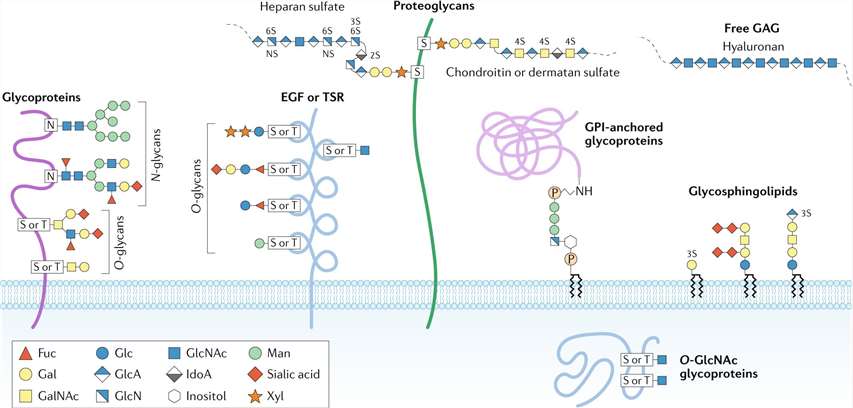Glycosylation Analysis Service
Glycosylation stands as an indispensable and prevalent post-translational modification of proteins, with over half of proteins undergoing glycosylation modifications. Its significance lies in its pivotal role in upholding normal physiological functions in organisms, making it a key focus in omics research. Creative Proteomics excels in delivering top-notch glycosylation analysis services, encompassing identification, quantification, and characterization, promising valuable insights for your protein research initiatives.
What is Glycosylation
Protein glycosylation is a multifaceted and crucial post-translational modification where sugar molecules covalently bind to proteins. This intricate and highly regulated process unfolds in the endoplasmic reticulum and Golgi apparatus. Glycosylation manifests in two primary forms: N-glycosylation, occurring on asparagine residues, and O-glycosylation, occurring on serine/threonine residues. These modifications bestow a broad spectrum of structural and functional diversity on proteins.

Fig.1 Schematic of Glycosylation (Reily, C.;et al., 2019)
N-glycosylation involves attaching complex oligosaccharides to specific asparagine residues within the consensus sequence Asn-X-Ser/Thr. In contrast, O-glycosylation encompasses the stepwise addition of sugar residues, typically commencing with N-acetylgalactosamine (GalNAc), to serine or threonine residues. This process contributes significantly to the intricate landscape of protein modifications.
Applications of Glycosylation Analysis
Protein glycosylation is integral to numerous cellular processes, and dysregulation of glycosylation is implicated in various diseases, making it a target for diagnostic and therapeutic strategies. Cancer cells often exhibit altered glycosylation patterns, and specific glycan signatures can be used as diagnostic markers. Therapeutic proteins, such as monoclonal antibodies, are engineered to ensure proper glycosylation, as it can impact their efficacy and safety. Therefore, protein glycosylation has applications in many fields, for example:
- Cell Signaling Study
- Disease Research
- Drug Development
- Therapeutic Development
Our Service
Creative Proteomics has advanced protein detection technologies and can provide customized services to researchers and scientists to help them reveal the complexity of PTM using powerful mass spectrometry technologies. Our protein glycosylation analysis services include:
Workflow of glycosylation analysis service

Fig.2 Glycosylation analysis workflow
- Sample Preparation
Proper extraction and preparation of proteins from biological samples to ensure preservation of glycosylated proteins. - Glycosylation Enrichment
Enrichment techniques are employed to isolate glycosylated proteins or peptides. This step is crucial as glycosylation modifications are often present in low abundance compared to unmodified proteins. - Detection
LC-MS/MS is a powerful tool for identifying and quantifying glycosylated peptides, providing sequence information that helps to identify glycosylation sites. - Bioinformatics Analysis
Advanced bioinformatics tools are used to analyze data, identify glycosylated peptides, and map these modifications to protein sequences. - Result Delivery
After professional data analysis, we deliver results quickly and consistently.
Why Choose Us
- Rich experience in proteomics research
- Excellent research team and professional platform
- Unique and comprehensive research services in proteomics field
- Reliable data and results
Creative Proteomics brings a wealth of experience to the field of protein research. Our comprehensive services and products cover the entire spectrum of utilizing suitable and efficient gateways. Utilizing our proprietary platform, we have successfully implemented many proteomics research projects. If you are interested, please contact us for more information and a quote.
Reference
- Reily, C.; et al. Glycosylation in health and disease. Nature Reviews Nephrology. 2019, 15(6): 346-366

